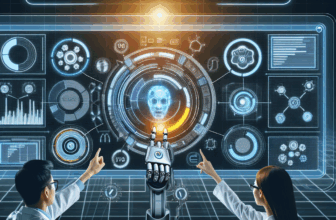Unlocking Sales Potential: The Benefits of AI-Driven Smart Product Descriptions
Table of Contents
- 1. Introduction
- 2. What are Smart Product Descriptions?
- 3. The Importance of Product Descriptions in E-Commerce
- 4. Key Benefits of AI-Driven Product Descriptions
- 5. Challenges and Limitations of AI in Product Descriptions
- 6. Real-Life Examples and Case Studies
- 7. Frequently Asked Questions (FAQ)
- 8. Resources
1. Introduction
The digital landscape is undeniably shifting, and with it comes an ever-growing demand for businesses to optimize their online presence. Central to e-commerce success is the product description—a tool that not only informs but persuades consumers to make purchase decisions. In this context, the integration of Artificial Intelligence (AI) into creating product descriptions is revolutionizing how retailers engage with customers.
This article takes an in-depth look at AI-driven smart product descriptions—what they are, their benefits, and potential limitations. We’ll explore how they enhance sales potential and ultimately reshape the e-commerce landscape.
2. What are Smart Product Descriptions?
2.1 Definition
Smart product descriptions refer to content generated using AI algorithms and natural language processing (NLP) technologies. Unlike traditional product descriptions, which are crafted manually, smart descriptions can adapt to various factors like user behavior, market trends, and even individual customer preferences.
2.2 How AI-Driven Descriptions Work
The process of generating smart product descriptions involves several key components:
- Data Processing: The AI system processes extensive datasets, including prior purchase histories, consumer reviews, and browsing behaviors.
- NLP Algorithms: These algorithms help the AI understand the context of products, translating data into human-understandable text.
- Machine Learning: Over time, machine learning allows AI to improve its descriptions based on user feedback and engagement metrics.
3. The Importance of Product Descriptions in E-Commerce
3.1 Role in Conversion Rates
Effective product descriptions are a significant factor in conversion rates. They not only provide necessary information but also evoke emotions and generate interest. Research has shown that high-quality product descriptions can boost conversion rates by up to 30%.
3.2 SEO Impact
Search engine optimization (SEO) is critical for online visibility. Well-crafted product descriptions containing targeted keywords can increase organic traffic and improve search rankings. AI tools can assist in identifying relevant keywords and ensuring optimal keyword placement within descriptions.
4. Key Benefits of AI-Driven Product Descriptions
4.1 Personalization at Scale
One of the most significant advantages of AI-driven product descriptions is the ability to personalize content for various audience segments at scale. AI can analyze customer data and tailor descriptions to meet specific preferences and behaviors.
4.2 Consistency and Speed
AI systems offer unprecedented speed and consistency in generating product descriptions. While manual writing may lead to variations in tone and style, AI can maintain consistent branding and accelerate content generation processes across extensive product catalogs.
4.3 Multilingual Capabilities
As businesses expand globally, the need for multilingual content grows. AI can effortlessly generate product descriptions in various languages, ensuring that brands maintain a cohesive message worldwide. This capability not only broadens market reach but also fosters inclusivity.
5. Challenges and Limitations of AI in Product Descriptions
5.1 Accuracy and Authenticity
While AI technologies are advanced, they are not infallible. There are concerns about the accuracy of information generated, especially for products that require nuanced descriptions. Authenticity is also a potential issue, as overly generic descriptions may not resonate with target audiences.
5.2 Creative and Emotional Limits
Creativity remains one area where human writers excel. AI-generated descriptions may lack emotional depth and the ‘human touch' that some products require for effective storytelling. Brands need to balance AI efficiency with the need for genuine, engaging narratives.
6. Real-Life Examples and Case Studies
6.1 Case Study 1: Retailer A
Retailer A, a leading online fashion store, implemented an AI-driven content generation system to improve its product descriptions. Over six months, the retailer reported a 25% increase in conversion rates and a 15% decrease in bounce rates, attributing success to optimized descriptions matched with consumer data.
6.2 Case Study 2: Retailer B
Retailer B, specializing in home goods, adopted AI technology to generate descriptions in multiple languages. As a result, they expanded into five new markets within a year. Their multilingual capabilities supported a revenue increase of 40% in these new regions, showcasing the international potential of AI-driven descriptions.
7. Frequently Asked Questions (FAQ)
- Q: Can AI-generated descriptions match those created by humans?
A: While AI can generate appealing and informative product descriptions, they may lack the emotional and creative touch that human writers provide.
- Q: What types of businesses can benefit from AI-driven product descriptions?
A: Any business with an online presence can leverage AI-generated descriptions, from e-commerce retailers to service-based websites.
- Q: How do AI descriptions impact user experience?
A: AI descriptions can enhance user experience by providing relevant information, helping customers make informed decisions quickly.
8. Resources
| Source | Description | Link |
|---|---|---|
| Shopify Blog | Insightful articles on e-commerce trends, including product descriptions. | shopify.com/blog |
| HubSpot | Resources on content marketing and SEO best practices. | blog.hubspot.com |
| Gartner | Research on emerging technologies in business. | gartner.com |
| McKinsey & Company | Insightful market reports and strategies. | mckinsey.com |
Conclusion
AI-driven smart product descriptions stand at the forefront of digital marketing strategy in the e-commerce domain. By understanding their benefits and limitations, businesses can effectively harness this technology to drive sales, engage customers, and enhance overall user experience. As this technology continues to evolve, companies must stay tuned to new advancements and adapt their strategies accordingly.
By investing in AI-driven solutions, businesses can not only unlock their sales potential today but also prepare for the future landscape of online shopping.
Disclaimer: This article is produced by A.I. and is in Beta Testing. The information presented here is curated from various sources and is intended for informational purposes only. Always consult a professional before making any significant business decisions.










